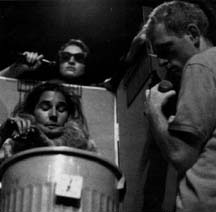
Shut Up I Tell You
(I Said Shut Up I Tell You) • Press
Shut Up I Tell You (I Said Shut Up I Tell You) P.S. 122
by Steven Drukman
In an admittedly spotty theatrical season, the work of Elevator Repair Service, in a whirligig of sideshow-style shenanigans titled Shut Up I Tell You (I Said Shut Up I Tell You), 1996, stands out not only for its humor and intelligence, but also for its defiant theatricality—in fact, the performance was one of the most intriguing theatrical events I’ve experienced in quite some time. The troupe is fond of low-maintenance props (e.g., a medieval sentry “played” by a plastic skull attached to a broomstick, peering over a folding screen) and set pieces (e.g., tattered vinyl high chairs, carpet remnants with tape markings) that underline their artifice and, hence, theatricality. The two plots of the evening (part one is about castles and vampires, part two concerns—hang on—Freemasonry) are really just occasions for ludic display. Much of the ensemble’s manic energy goes into a seamless, rapid-fire presentation of found texts. The choreography, despite its apparent offhandedness, requires great timing and proficiency—like a sudden flip of an appliance into a pink garbage can, just one of the many minor engineering feats that punctuated the evening. These seemingly low-rent antics, however, are amplified by state-of-the-art sound effects and musical sampling. Strains that sound as if they came straight out of La Dolce Vita slide nostalgically into a riff from the Eagles’ One of These Nights, while performers spring back flips off prefab furniture that cannot really support such activity. It is the troupe’s fascination with antiquated technology—a scrutiny of planned obsolescence—that directs attention toward the presence of the actors’ bodies in time and space. This formal disjunction is almost the group’s cachet: it is rare to find so sophisticated a sense of aurality along with such raw, performative virtuosity. Magic and slapstick also play a large part in ERS’ theatrical stew, augmenting their harebrained tales of cathedrals not built by “retarded assistants” who are allergic to ink. I especially Iike part one of Shut Up I Tell You, in which the pratfalls and prestidigitation tarted-up fragments of an obscure radio play. The performers have a penchant for the preposterous, whether in an outlandish Jamaican cadence, hip-hop dancing interludes that point to rhythmic jaw thrusts, or late-19th-century psychoanalytic sessions mumbled into microphones. ERS is representative of a generation of performers that was weaned on Richard Foreman and the Wooster Group, sweetly merging the mind-bending perception play of the former with the hi-tech hijinks of the latter. The troupe is a sort of recombinant DNA of discrete theatrical strands. Much of ERS’ success lies in its confidence that the elements of this unabashed admixture will work together. The overall effect is of an altered and wholly original spectatorial experience, something Foreman-esque in its aims. So while the pulse of the experimental theater has felt faint in New York this winter, ERS has demonstrated that the scene still has an EKG. Thank you, good folks of Elevator Repair Service, for giving me a lift.